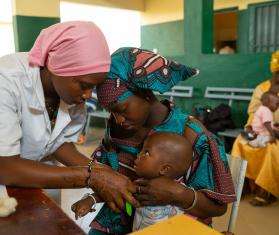In the town of Gao, in conflict-riven northern Mali, an average of 120 patients make their way to the Doctors Without Borders/Médecins Sans Frontieres(MSF) Wabaria and Sossokoira health centers each day. Even though the rainy season is over, 70 percent come with malaria, a potentially fatal parasitic disease that leaves sufferers exhausted from high fevers and uncontrollable shivers. Despite the war, it is malaria that the MSF medical teams in the region are battling most fiercely. It remains the leading cause of death in the country, and it is particularly dangerous for children under the age of five.
“Since we started working in the health centers in September last year, we have generally seen a constant number of patients,” says Dr. Jose Bafoa, MSF’s medical team leader in Gao. “There was a dip in mid-January during the air strikes, and again this week we received fewer than 10 patients a day in one of our health centers following renewed fighting. But patient numbers consistently go back to normal when things calm down and people are less frightened of leaving their homes. In that particular health center, for example, we are now receiving an average of 60 patients again.”
He continued: “Although there is a hospital and 10 health centers in and around Gao town, this is for a population of 400,000, and we realized that some people still had no access to medical care. And with the current insecurity, where people are on the move and often have even fewer means, giving them access to free and quality care is even more vital. So far we have attended to 16,000 patients.”
In January, French and Malian forces launched an offensive against various armed groups operating in the north. In Gao, the most significant force is the Movement for Unity and Jihad in West Africa, a splinter group of the better known Al-Qaeda in the Islamic Maghreb (AQMI).
“People fled in fear of the air strikes and reprisal attacks,” Dr. Bafoa says. “Some went to neighboring countries, but others found shelter in small villages or in the bush, where living conditions are harsh. So aside from malaria, we have seen an increase in the number of patients coming in with diarrhea and skin diseases due to the lack of hygiene, as well as an increase in cases of acute respiratory infections caused by the dust and wind. More patients are also coming in with high blood pressure and gastritis, likely due to the high levels of stress they have faced recently.”
The main aim of the project is to reduce mortality rates by increasing access to health care and emergency response. And indeed, Dr. Bafoa explains that before the project was launched, there were at least one or two deaths per week in the three health structures that MSF supported in Gao (the Wabaria and Sossokoira projects are still running, as noted above, but MSF is now only sending supplies to the project in Chabaria due to security risks). Since the project got underway, however, there have been only five. Further south, in the town of Ansongo, where MSF supports the referral hospital, mortality rates in the center have also decreased, from over 8 percent less than three months ago to 1.2 percent today.
And in the vast desert areas of northern Mali, bringing treatment closer to patients has proven essential. For the past four months, mobile teams have worked in remote areas, seeking out patients who will not or cannot travel to the project sites. But, with fears of land mines on the roads, MSF has been forced to temporarily suspend its mobile clinics. “Through our mobile clinics, we of course provided primary health care, but we also tried to ensure that pregnant women would have routine prenatal consultations,” says Dr. Bafoa. “We do not know when we will be able to re-start them, but we hope it will be soon.”
MSF also supports other community health centers, supplying them with medicines and essential materials. As Dr. Bafoa explains, “The main problem we face here in Gao and Ansongo is a lack of materials and good working conditions. So aside from giving training and support to local staff, we have also done a lot of work rehabilitating existing structures. In Ansongo referral hospital, for example, we re-established the electricity and running water, and we are now rehabilitating the operating theater.”
Epidemiological surveillance is another key aspect of the project, to ensure that teams are able to respond to disease outbreaks rapidly. “We need to be ready to respond to any medical eventuality, be it an outbreak, war-wounded, or people affected by displacement,” says Dr. Bafoa. “In Ansongo, our teams went in in December to support the local hospital, and now we see some 100 patients per day. And although we have two Malian colleagues who were already here doing Caesarean sections and providing other obstetric care, we sent a surgeon specialized in war-related trauma."
“Our patients tell us that all they hope for is peace,” he continued. “And we are with them; we stayed here throughout the air strikes, we will not abandon our patients now. We hope that the health system will develop and eventually replace us. But until then, we will stay and ensure that the people of Gao and Ansongo continue to have access to quality and free health care”.
In northern Mali, MSF teams work in Gao, Ansongo, Konna, Mopti, Douentza, and Timbuktu providing primary and secondary health care, surgery, and emergency response. MSF is also working in the south of the country, running a comprehensive pediatric program (primary and secondary preventive and curative care) in the region of Sikasso. The medical humanitarian organization also provides care to Malian refugees in the neighboring countries of Burkina Faso, Mauritania, and Niger.





